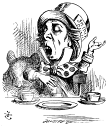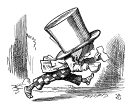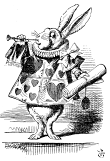Search us!
Search The Word Detective and our family of websites:
This is the easiest way to find a column on a particular word or phrase.
To search for a specific phrase, put it between quotation marks. (note: JavaScript must be turned on in your browser to view results.)
Ask a Question! Puzzled by Posh?
Confounded by Cattycorner?
Baffled by Balderdash?
Flummoxed by Flabbergast?
Perplexed by Pandemonium?
Nonplussed by... Nonplussed?
Annoyed by Alliteration?

Don't be shy!
Send in your question!
Columns from 1995 to 2006 are slowly being added to the above archives. For the moment, they can best be found by using the Search box at the top of this column.
 If you would like to be notified when each monthly update is posted here, sign up for our free email notification list.
If you would like to be notified when each monthly update is posted here, sign up for our free email notification list.
Trivia
All contents herein (except the illustrations, which are in the public domain) are Copyright © 1995-2020 Evan Morris & Kathy Wollard. Reproduction without written permission is prohibited, with the exception that teachers in public schools may duplicate and distribute the material here for classroom use.
Any typos found are yours to keep.
And remember, kids,
Semper Ubi Sub Ubi
|
Not our sort, Angus.
Dear Word Detective: Some time ago I encountered the word “clamjamfry,” which I was told referred to “the worthless masses.” I’ve consistently used it as an alternative to “hoi polloi.” One thing that has me nonplussed is that I have never discovered this word in any kind of reputable dictionary. The word certainly sounds as though it has a heck of an origin. Can you shed any light on this term, which appears to be a poster-child for recondite speech? — Topher D.
I must admit that there are times, writing this column, when I feel a bit like a performing hamster. Someone asks a question, I jump into the wheel, work my little paws furiously until I find the answer (or, occasionally, don’t), jump out of the wheel, trot over to my tiny hamster typewriter and put it all down with the old hunt-and-peck. Then I have a Lilliputian cup of joe and pick another question. It can get a little monotonous.
But I found this question instantly intriguing. I am, it is true, easily intrigued (you should see the junk I’ve bought on eBay), but I eagerly went looking for “clamjamfry.”
The first stop in my search was, as usual, the Oxford English Dictionary (OED), where I found no listing. Bummer. But I then found some internet references for “clamjamfry” indicating that it might be a Scots dialect term, so I checked the excellent online Dictionary of the Scots Language (www.dsl.ac.uk). Bingo! “Clamjamfry” is defined as “A company of people; generally used contemptuously, hence a mob, rabble, the riff-raff of a community.” It can also mean “Hurly-burly, row, commotion” and “Worthless odds and ends, rubbish,” a sense now largely obsolete. As a verb, “clamjamfry” means “to crowd or clutter up,” “to chatter or gossip” and “to roam about aimlessly, to loiter.”
The Dictionary of the Scots Language also listed a variety of alternate spellings of “clamjamfry,” so I went back to the OED and discovered the word was indeed listed, under “clamjamphrie,” with the same basic definitions. It seems to have first appeared in Scots and Northern England dialects in the early 19th century, and its exact roots are a mystery. The OED, however, suggests that “clamjamfry” is a combination of “clan” (in the Scottish sense of “ancestral group”) plus “jampher,” a Scots dialect word meaning “trifler, idler.” That would give “clamjamfry” the meaning of “the riff-raff or rabble of a clan,” which would certainly match the sense of “hoi polloi” (“the common people,” from Greek for “the many”).
The best thing about “clamjamfry” is that it is still very much in use in Scotland and the rest of the UK today (“As the last of the children’s banners swept down the Mound the guests, by now a wholly disordered clamjamfrey, ambled back up the hill for their lunch in Parliament Hall,” 1999). So now we have a great new word to play with.
“Digress” is my middle name.
Dear Word Detective: How did the “polka dot” get its name? — Chris Owens.
That’s an interesting question, but there was something about the way you phrased it that struck me as odd, and it took a moment before I realized what it was. One does not often, if ever, see the phrase “the polka dot.” As a matter of fact, you could argue (and I love to argue, which may be why I don’t get invited to more parties) that a single “polka dot” is not a “polka dot” at all, but merely a “dot,” and usually a pretty boring dot at that. Not like a microdot at the center of a spy story, or a suspicious dot on a satellite photograph, or even a dot of marinara sauce on your glasses after you’ve been eating spaghetti. Just a boring old dot.
Onward. The Oxford English Dictionary defines “polka dot” as “Any of a number of round dots of uniform size repeated so as to form a regular pattern, usually on fabric.” The term itself first appeared in the mid-1800s (“Scarf of muslin, for light summer wear … surrounded by a scalloped edge, embroidered in rows of round polka dots,” 1857), and “polka dot” fabrics have been intermittently fashionable ever since. I don’t spend a lot of time monitoring current fashion, but my sense is that polka dot designs are (except among the preciously retro) considered uncool at the moment (“Wooden cutouts of Granny bending over in her flowerbed exposing her polka-dot bloomers,” At Home in Heart of Appalachia, 2001).
“Polka dots” are obviously “dots” (from the Old English “dott,” meaning “speck”), so the question is what “polka” has to do with the pattern. The “polka” is a dance, simple and lively as dances go, which took Europe and America by storm soon after its introduction in 1835. The name “polka” is itself a bit of a mystery. “Polka” is Polish for “Polish woman,” but the “polka” dance is actually of Bohemian origin. Some authorities believe that “polka” may actually be a corruption of the Czech word “pulka” (“half”), referring to the short half steps involved in the dance.
So, what does the polka dance have to do with polka dots? Essentially nothing. The polka craze, which lasted for several decades in the 1800s, was sufficiently intense to inspire manufacturers to append “polka” to the name of a wide variety of completely unrelated products in an attempt to capitalize on polka-mania. There were several items of clothing and even food labeled “polka” at the time, much as the prefix “cyber” was slapped on everything from TV news shows to dog food in the mid-1990s. Most of such “polka” tie-ins disappeared as the dance fad faded. “Polka dots,” however, survived (as did the polka itself).
Followed by “Driving the porcelain bus.”
Dear Word Detective: Where did the expression “three sheets to the wind” come from? –Susan.
That’s a good question, but I have one of my own. “Three sheets to the wind” means, as most people know, “very drunk, extremely inebriated.” But does anyone actually use this expression today? I’ve never been much of a drinker myself (I think I last drank a beer about six years ago, for example). But I see people weaving loudly and unsteadily out of the sports bar at the local mall on weekends, dressed like overgrown toddlers in football regalia, and I find it hard to believe that at the office on Monday they say “Joe was really three sheets to the wind Saturday night.” “Blitzed,” “blotto” “hammered,” “loaded,” “looped” or “sloshed” I can buy. But “three sheets to the wind” seems a bit too ornate for a culture that worships plasma TVs.
Nonetheless (now there’s a good word), “three sheets to the wind” is a vivid and venerable phrase. The first example of “three sheets to the wind” found in print so far is from 1821 (in the form “three sheets in the wind”), but the expression is almost certainly much older. Today new slang is instantly immortalized by newspapers, magazines and TV, but before the mid-20th century, much slang circulated in oral use for decades and sometimes much longer before making it into print.
In the mood for some irony? Nine out of ten urban legends about the origins of words or phrases erroneously trace them to seafaring traditions and the age of tall ships. There’s even an acronym for the folks who propagate this nonsense: CANOE (Committee to Assign a Nautical Origin to Everything). But “three sheets to the wind” really does have a nautical origin. The “sheets” in the phrase are the lines (ropes) that hold a sail in place. If one of the “sheets” (from the Old English “sceata,” meaning the corner of a sail) comes loose, the sail flaps in the wind and causes the ship to lose power. If two sheets are loose and fluttering in the wind (or “to the wind”), you’re in major trouble, and “three sheets in the wind” means the ship is uncontrollable, reeling like a drunken sailor. Thus “three sheets to the wind” was the perfect metaphor for, at first, a sailor who had celebrated a bit too much on shore leave, and eventually anyone who was too drunk to walk steadily.
According to legend, “three sheets to the wind” was originally just one stage in a scale of drunkenness used by sailors, ranging from “one sheet to the wind” (slightly tipsy) to “four sheets to the wind” (unconscious). The Oxford English Dictionary does list “a sheet in the wind” as meaning “slightly drunk,” so such a classification system may actually have existed. Or, of course, it may just be another nautical fable.
|
Makes a great gift! Click cover for more.  
400+ pages of science questions answered and explained for kids -- and adults!
FROM ALTOIDS TO ZIMA, by Evan Morris
 
|


 can be found
can be found 




Recent Comments